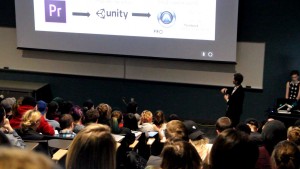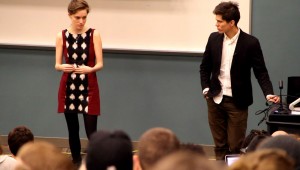Ohio University Students Compare Their Virtual Reality Efforts to High-Tech Start Up
By: Rachel Cherry
Posted on:
A group of media students gathered in a lecture hall to view a presentation by the high-tech startup Embodied Labs Tuesday morning. However, the visitors were unaware that a team of Ohio University students and professors have been working on a similar project in Athens this past year. Both groups are using virtual reality media to help educate students in another field of study: medicine.

About Each Group
Ohio University
The Innovation Media Initiative received an $878,000 grant to help students experience the virtual reality field. The University’s Innovation Strategy program is using the money for hands-on research and projects.
Classes in VR began this summer and will continue in a three-tier class structure to mentor students. Though the program is based in Scripps College of Communication, it partners with the Heritage College of Osteopathic Medicine, College of Health Sciences and Professions, College of Arts and Sciences, Russ College of Engineering and Technology and Patton College of Education.
Embodied Labs creative director Ryan Lebar said, “Ohio University could become a center for virtual reality.”
Embodied Labs
Carrie Shaw, a medical illustrator and health educator, and graduate of the University of North Carolina, started Embodied Labs to create a learning experience for medical students. Shaw along with four others, created “Alfred,” a system that creates an immersive case study through virtual reality. Embodied Labs sells its program to schools across the country to teach medical students how patients go through daily tasks.

Medical Virtual Reality
Both groups have used virtual reality to create programs that help educate medical students.
While they both have the same goal, each product is a bit different.
Ohio University
-created camera rig for students to experience emergency-room training
-filmed mock rescue mission at scene of car accident
-explored issues such as reducing anxiety in blood donors and helping patients recover from low back pain
Embodied Labs’ “Alfred” System
-follows a virtual patient with macular degeneration and hearing loss
-more about learning how the patient feels and less about skills
Revenue Potential
Virtual Reality is a growing field with a lot of potential. Since real-life experiences are not easily reproduced, the virtual-reality products are highly valued. The lowest price for an Embodied Labs’ product is $10,000 dollars a year for a single academic institution. EL’s pricing structure will change next September to include different tier levels based on users.
Those working with Ohio University’s VR initiative said the effort not only provides an impressive educational opportunity, but can eventually become a source of revenue as well. Ohio University is one of only a few institutions in the U.S. working with VR technology.

